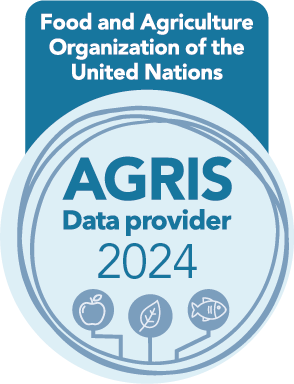Safety of some biopesticides towards ladybird beetles and rove beetle on cowpea, Vigna unguiculata (L.)
DOI:
https://doi.org/10.14719/pst.6516Keywords:
biopesticides, field trials, ladybird beetles, rove beetle, safetyAbstract
Field trials were conducted at the Agricultural Research Station, Faculty of Agricultural Sciences, SOADU, Binjhagiri, Khurdha, during the rainy season of 2022 and winter of 2022-23 to evaluate the safety of five biopesticides on predators in cowpea crops. Four species of ladybird beetles and one species of rove beetle (Paederus fuscipes Curtis) were observed. Among the ladybird beetles, Coccinella repanda Thunberg was the predominant species, accounting 43.84% of the total population, followed by Cheilomenes sexmaculata Fab. (31.51%), Micraspis discolour Fab. (15.07%) and Brumoides suturalis Fab. (9.59%). The treatments included Bacillus thuringiensis var. kurstaki (16000 i.u./ mg) at 1.0 Kg/ha, Beauveria bassiana (108 cfu/g) at 2.5 Kg/ha, Metarrhizium anisopliae (108 spores/g) at 2.5 Kg/ha, Lecanicillium lecani (108 cfu/g) at 2.5L/ha, azadirachtin (300 ppm) at 2.5 L/ha, chlorantraniliprole (18.5% active ingredient) at 0.25 L/ha (chemical check) and an untreated control. All the biopesticides proved to be safe for ladybird beetles and the rove beetle. B. thuringiensis var. kurstaki was the safest, recording only 3.94% and 3.40% reductions in ladybird population five days after application during the rainy season of 2022 and winter of 2022-23, respectively. It was followed by B. bassiana (6.35% and 4.45% reduction), M. anisopliae (8.97% and 7.33% reduction), L. lecani (10.28% and 8.90% reduction) and azadirachtin (19.04% and 26.96% reduction). A similar trend was observed in rove beetle, with respective reduction of 5.07% and 3.79%, 5.67% and 4.92%, 6.87% and 6.06%, 7.76% and 6.82% and 17.31% and 26.14%.
Downloads
References
Degri MM, Maina YT, Richard BI. Effect of plant extracts on post flowering insect pests and grain yield of cowpea (Vigna unguiculata (L.) Walp.) in Maidugur, semi-arid zone of Nigeria. J Biol, Agric Healthcare. 2012;2(3):46-56.
Bittenbender HC. Handling and storage of cowpea (Vigna unguiculata (L.) Walp.) as a leaf vegetable. Trop Agric. 1990;69:197-200.
Singh SR, Emden HV. Insect pests of grain legumes. Annu Rev Ento. 1979;24(1):255-78. https://doi.org/10.1146/annurev.en.24.010179.001351
Chhangani G, Mahla MK, Swaminathan R, Kumayat K, Choudhary RS, Vikram. Diversity of natural enemies associated with insect pests of cowpea in Southern Rajasthan. Pharma Innov J. 2021;SP-10(12):788-90.
Agale SV, Rangarao GV, Ambhure KG, Gopalakrishnan S, Wani SP. Effect of selected bio-pesticides on natural enemies in pigeon pea (Cajanus cajan L.) crop. J Ento Zool Std. 2019;7(2):91-95.
Singh TR. Bio-efficacy of some novel insecticides in controlling insect and mite pests of capsicum. M Sc [Thesis] Odisa University of Agriculture and Technology, Bhubaneswar; 2017
Rangaswamy R. A textbook of agricultural statistics. New Age International, New Delhi; 1995. p. 269-79
Wagner T, Neinhuis C, Barthlott W. Wettability and contaminability of insect wings as a function of their surface sculptures. Acta Zoologica. 1996;77(3):213-25. https://doi.org/10.1111/j.1463-6395.1996.tb01265.x
Fiuza LM. Receptores de Bacillus thuringiensis em insetos. Biotecnologia Ciência e Desenvolvimento. 2004;32:84-89.
Bajya DR, Ranjith M, Raza SK. Evaluation of Beauveria bassiana against chickpea pod borer, Helicoverpa armigera and its safety to natural enemies. Indian J Agric Sci. 2015;85(3):378-81. https://doi.org/10.56093/ijas.v85i3.47122
Sahu N, Mandal SMA. Safety of cyazypyr and microbial pesticides against ladybird beetles and spiders in capsicum. J Ento Zool Std. 2020;8(2):491-93.
Khan AA. Bio-efficacy of botanical pesticides against mealy cabbage aphid (Brevicoryne brassicae L.) and bio-safety against its natural enemies in cruciferous vegetable ecosystem of Kashmir. J Ento Zool Std. 2021;9(2):1332-36.
Praveenkumar C, Kandibane M. Bioefficacy of botanical extracts against black gram borer pests and safety to their natural enemies. Biological Forum – An Int J. 2022;14(4a):01-06.
Singh S, Das B, Devi HL, Sunani SK, Suklabaidya A, Majumder P. Evaluation of biorational pesticides against Bemisia tabaci Gennadius and Amrasca biguttula Ishida and its impact on natural enemies population in cowpea ecosystem. Arch Phytopathol Plant Protect. 2022;55(1):63-75. https://doi.org/10.1080/03235408.2021.1994268
Thakar PK, Patel JR, Rabari PH. Bio-efficacy of pesticides against aphid, Aphis craccivora Koch in cowpea and its effect on natural enemies. J Ento Res. 2023;47(1):126-34. https://doi.org/10.5958/0974-4576.2023.00022.1
Cloyd RA, Herrick NJ. Effects of pesticides on the survival of rove beetle (Coleoptera: Staphylinidae) and insidious flower bug (Hemiptera: Anthocoridae) adults. J Econ Ento. 2018;111(1):78-88. https://doi.org/10.1093/jee/tox280
Guo M, Wang Z, Cai W, Hua H, Zhao J. Safety assessment of transgenic Cry2Aa rice to a generalist predator, Paederus fuscipes Curtis (Coleoptera: Staphylinidae). Ecotoxicology and Environmental Safety. 2020;200:110719. https://doi.org/10.1016/j.ecoenv.2020.110719

Downloads
Published
Versions
- 15-04-2025 (2)
- 10-04-2025 (1)
How to Cite
Issue
Section
License
Copyright (c) 2025 Biswojit Mishra, S M Abdulla Mandal, Bhubanananda Adhikari, Soubindra Kumar Padhi

This work is licensed under a Creative Commons Attribution 4.0 International License.
Copyright and Licence details of published articles
Authors who publish with this journal agree to the following terms:
- Authors retain copyright and grant the journal right of first publication with the work simultaneously licensed under a Creative Commons Attribution License that allows others to share the work with an acknowledgement of the work's authorship and initial publication in this journal.
- Authors are able to enter into separate, additional contractual arrangements for the non-exclusive distribution of the journal's published version of the work (e.g., post it to an institutional repository or publish it in a book), with an acknowledgement of its initial publication in this journal.
Open Access Policy
Plant Science Today is an open access journal. There is no registration required to read any article. All published articles are distributed under the terms of the Creative Commons Attribution License (CC Attribution 4.0), which permits unrestricted use, distribution, and reproduction in any medium, provided the original author and source are credited (https://creativecommons.org/licenses/by/4.0/). Authors are permitted and encouraged to post their work online (e.g., in institutional repositories or on their website) prior to and during the submission process, as it can lead to productive exchanges, as well as earlier and greater citation of published work (See The Effect of Open Access).









